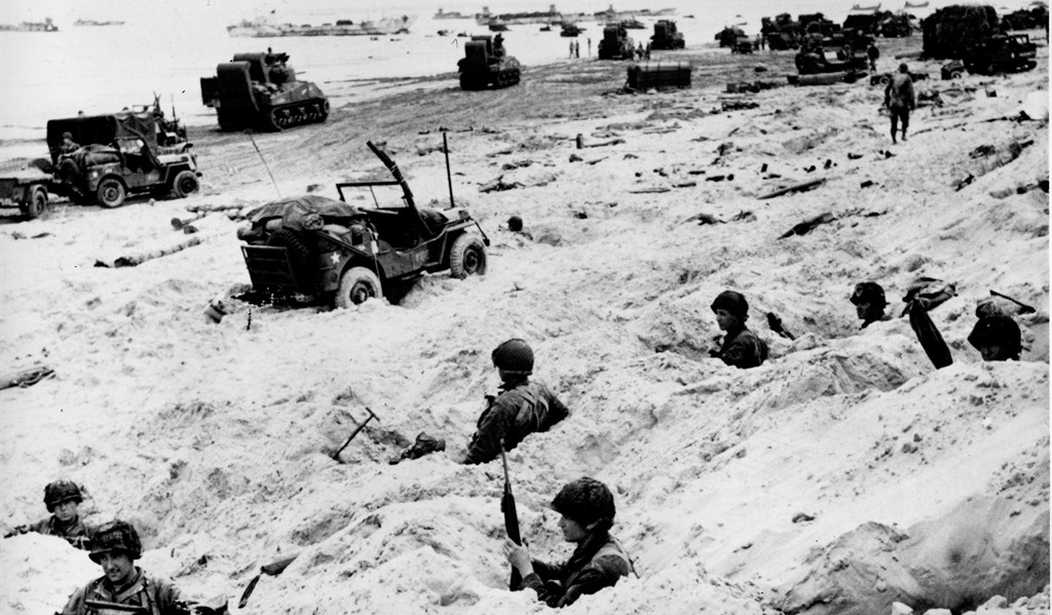Imagine picking up every man in a medium-sized city, everything they’ll need to eat and drink and rest for a few days, any vehicles they might need, gasoline, of course, plus lots of guns and ammo — did I mention this was a hunting trip? — and then moving all those men and all that stuff in a few short hours a distance of anywhere from 30 to 125 miles or so.
Now imagine that you have to move all those people and all that stuff partly by air, but mostly across heavy seas in foul weather.
Under enemy fire.
I should also mention that if you messed up any of the big details, a lot of your people are going to die, and then you’re going to have to figure out how to move the survivors back to where they came from without getting too many more of them killed.
All that is just the beginning.
Because once you’ve gotten 120,000 men on that “hunting trip,” they're going to have to take and widen a beachhead big enough and secure enough that you can rebuild (or build from scratch!) the ports and roads necessary to bring another million men over… plus all the additional stuff all those additional men will need.
That, in a logistical nutshell, was what the Allies had to accomplish 80 years ago today on D-Day.
Supreme Commander, Allied Expeditionary Force, General Dwight Eisenhower named it "Operation Overlord" for very good reason.
Ike also said, “In preparing for battle I have always found that plans are useless, but planning is indispensable.” What he meant was this. "No plan survives first contact with the enemy," as everyone from Sun Tzu to Carl von Clausewitz noted over the millennia. But without a lot of planning, you won't even make it to the fight or, if you do, you'll get slaughtered.
The planning that went into Overlord boggles the mind.
Recommended: Newspaper Publishes Most Obvious Thing Ever, Everybody Goes Bat-Guano Crazy
The units involved included six American combat divisions under First Army, landing at German-held French beaches code-named Omaha and Utah. There were four infantry divisions tasked with storming the fortified beaches, plus two airborne divisions for landing by parachute and glider behind German lines. British Second Army brought four more divisions to the fight, including 6th Airborne and the 3rd Canadian Infantry Division. And the British 79th Armored Division provided troops and specialized landing vehicles to the British sector.
The preparatory air bombardment was delivered by more than 2,000 Allied bombers. The invasion fleet included 1,200 warships, 4,125 landing craft, and another 1,600 support vessels of various kinds, all courtesy of eight different Allied nations. That’s about 7,000 ships, their crews, their supplies, and the tons and tons of fuel required to run them. The official count was nearly 200,000 naval personnel.
Keep in mind though that before any of that could happen, the skies first had to be swept clear of Axis aircraft and the Channel cleared of enemy mines. Just another reminder jotted down in Ike’s 87-million-page Trapper Keeper.
Three divisions worth of American and British paratroopers led the attack inland hours before the first leg infantry hit the shore. I’m not able to find solid figures on how many C-47s cargo planes and gliders were required, but a safe guess would be “a whole lot.”
The American airborne units got spread all over Hell and gone, and in the resulting chaos, only about 2,500 paratroopers were under their divisions’ command after a full day of fighting. The other 10,000 or so men had to accomplish their mission through initiative and improvisation. They also must have prayed that their supplies didn’t run out, or the Germans would surround them before they could hook up with Allied soldiers moving in from the beaches.
Some of those beaches were lightly defended by third-rate troops. Others not so much — particularly Omaha, which was a slaughterhouse. Confusion prevented USAAF bombers from smashing the beach defenses, and fickle Channel currents landed entire units in the wrong areas. Opposition was stiffer than expected, too — there were three times as many German troops as Allied intelligence projected.
Of the 32 tanks the troops counted on to support them, only five made it ashore. The rest foundered at sea, taking their crews with them. Of the 4,414 confirmed Allied dead on D-Day, nearly half were from the men tasked with taking Omaha Beach.
Nevertheless, they persisted. Securing the initial objectives took longer than expected but, in the end, the Germans didn’t stand a chance against the Allies’ logistical wherewithal, or the determination of individual soldiers, sailors, and airmen.
To prepare for all this, the U.S. delivered 1.9 million tons of supplies to Britain just in May of ’44. That’s 3,800,000,000 pounds of stuff in one month, with, I might remind you, more than a few German submarines hunting the merchant ships. To keep the fight going after the beaches were taken, another million troops were shipped to France in the four weeks after D-Day, along with more than 565,000 tons of supplies and a staggering 172,000 vehicles, from jeeps to tanks and every size and shape in between.
Recommended: UKRAINE WAR: What the Hell Is a Turtle Tank — and WHY?
To keep the vehicles moving, the Allies laid an undersea oil pipeline (called PLUTO) across the Channel. And to keep the troops fed and armed, they even hauled across transportable piers (called Mulberries) because the Normandy ports were too few and too small to bear the massive logistical strain.
If these huge numbers seem too abstract, remember that it was living, breathing men who made them happen. It was Allied officers and their staffs who made the plans. It was human beings who devised PLUTO and the Mulberry harbors. It was factory and shipyard workers who made the rifles, pistols, ammo, fighters, bombers, jeeps, trucks, tanks, and ships. Men and women in oilfields and refineries provided the oil, gas, and diesel which kept the war machines humming.
“Men of the West” manned the ships, flew the planes, hit the beaches, and airdropped in. It was fragile human bodies that endured the shelling, the bullets, and the rigors of what Eisenhower deemed the “Great Crusade,” the most logistically ambitious undertaking in human history… and a moral cause almost without parallel in history.
Those men saved Western Europe from the Nazis and also from “liberation” by Joseph Stalin's Red Army. The final battle lines our men drew just 11 months after D-Day soon became Stalin's Iron Curtain, where the West stood firm yet again against totalitarianism.
In other words, those men saved the world.
There are damned few of those people left, their numbers shrinking daily. You can forget the numbers but never forget them, what they did, or what they stood for.
Note: This is an edited, revised, and expanded version of an essay I wrote for the 75th Anniversary.










Join the conversation as a VIP Member